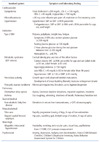1. Ha KH, Kim DJ. Epidemiology of childhood obesity in Korea. Endocrinol Metab (Seoul). 2016; 31:510–518.

3. Park MJ, Kim HS, Kang JH, Kim DH, Chung CY. Serum levels of insulin-like growth factor (IGF)-I, free IGF-I, IGF binding protein (IGFBP)-1, IGFBP-3 and insulin in obese children. J Pediatr Endocrinol Metab. 1999; 12:139–144.
4. Lee MH, Kim SH, Oh M, Lee KW, Park MJ. Age at menarche in Korean adolescents: trends and influencing factors. Reprod Health. 2016; 13:121.

5. Park MJ, Kang YJ, Kim DH. Dissatisfactioin with height and weight, and attempts at height gain and weight control in Korean school-children. J Pediatr Endocrinol Metab. 2003; 16:545–554.
6. Park MJ, Boston BA, Oh M, Jee SH. Prevalence and trends of metabolic syndrome among Korean adolescents: from the Korean NHANES survey, 1998-2005. J Pediatr. 2009; 155:529–534.

7. Berenson GS, Srinivasan SR, Bao W, Newman WP 3rd, Tracy RE, Wattigney WA. Association between multiple cardiovascular risk factors and atherosclerosis in children and young adults. The Bogalusa Heart Study. N Engl J Med. 1998; 338:1650–1656.

8. Li S, Chen W, Srinivasan SR, Bond MG, Tang R, Urbina EM, Berenson GS. Childhood cardiovascular risk factors and carotid vascular changes in adulthood: the Bogalusa Heart Study. JAMA. 2003; 290:2271–2276.

9. Moon JS, Lee SY, Nam CM, Choi JM, Choe BK, Seo JW, Oh KW, Jang MJ, Hwang SS, Yoo MH, Kim YT, Lee CG. 2007 Korean national growth charts: review of developmental pro-cess and an outlook. Korean J Pediatr. 2008; 51:1–25.

10. Barlow SE. Expert Committee. Expert committee recommendations regarding the prevention, assessment, and treatment of child and adolescent overweight and obesity: summary report. Pediatrics. 2007; 120:Suppl 4. S164–S192.

11. Zimmet P, Alberti KG, Kaufman F, Tajima N, Silink M, Arslanian S, Wong G, Bennett P, Shaw J, Caprio S. IDF Consensus Group. The metabolic syndrome in children and adolescents: an IDF consensus report. Pediatr Diabetes. 2007; 8:299–306.

12. Lee K, Lee S, Kim SY, Kim SJ, Kim YJ. Percent body fat cutoff values for classifying overweight and obesity recommended by the International Obesity Task Force (IOTF) in Korean children. Asia Pac J Clin Nutr. 2007; 16:649–655.
13. Park HW, Yoo HY, Kim CH, Kim H, Kwak BO, Kim KS, Chung S. Reference values of body composition indices: the Korean National Health and Nutrition Examination Surveys. Yonsei Med J. 2015; 56:95–102.

14. Song Y, Park MJ, Paik HY, Joung H. Secular trends in dietary patterns and obesity-related risk factors in Korean adolescents aged 10-19 years. Int J Obes (Lond). 2010; 34:48–56.

15. Kim SH, Park MJ. Phthalate exposure and childhood obesity. Ann Pediatr Endocrinol Metab. 2014; 19:69–75.

16. Ha K, Chung S, Lee HS, Kim CI, Joung H, Paik HY, Song Y. Association of dietary sugars and sugar-sweetened beverage intake with obesity in Korean children and adolescents. Nutrients. 2016; 8.

17. Kumar S, Kelly AS. Review of Childhood obesity: from epidemiology, etiology, and comorbidities to clinical assessment and treatment. Mayo Clin Proc. 2017; 92:251–265.
18. Van Cauter E, Holmback U, Knutson K, Leproult R, Miller A, Nedeltcheva A, Pannain S, Penev P, Tasali E, Spiegel K. Impact of sleep and sleep loss on neuroendocrine and metabolic function. Horm Res. 2007; 67:Suppl 1. 2–9.

19. August GP, Caprio S, Fennoy I, Freemark M, Kaufman FR, Lustig RH, Silverstein JH, Speiser PW, Styne DM, Montori VM. Endocrine Society. Prevention and treatment of pediatric obesity: an endocrine society clinical practice guideline based on expert opinion. J Clin Endocrinol Metab. 2008; 93:4576–4599.

20. Manco M, Dallapiccola B. Genetics of pediatric obesity. Pediatrics. 2012; 130:123–133.

21. Reekie J, Hosking SP, Prakash C, Kao KT, Juonala M, Sabin MA. The effect of antidepressants and antipsychotics on weight gain in children and adolescents. Obes Rev. 2015; 16:566–580.

22. Weiss R, Kaufman FR. Metabolic complications of childhood obesity: identifying and mitigating the risk. Diabetes Care. 2008; 31:Suppl 2. S310–S316.
23. Yoo EG, Park SS, Oh SW, Nam GB, Park MJ. Strong parent-offspring association of metabolic syndrome in Korean families. Diabetes Care. 2012; 35:293–295.

24. Weng SF, Redsell SA, Swift JA, Yang M, Glazebrook CP. Systematic review and meta-analyses of risk factors for childhood overweight identifiable during infancy. Arch Dis Child. 2012; 97:1019–1026.

25. Resnicow K, McMaster F, Bocian A, Harris D, Zhou Y, Snetselaar L, Schwartz R, Myers E, Gotlieb J, Foster J, Hollinger D, Smith K, Woolford S, Mueller D, Wasserman RC. Motivational interviewing and dietary counseling for obesity in pri-mary care: an RCT. Pediatrics. 2015; 135:649–657.

26. Pediatric Obesity Committee of Korean Society for the Study of Obesity. Obesity in children and adolescents: dietary intervention. Seoul: Chung Woon;2012.
27. Katzmarzyk PT, Barlow S, Bouchard C, Catalano PM, Hsia DS, Inge TH, Lovelady C, Raynor H, Redman LM, Staiano AE, Spruijt-Metz D, Symonds ME, Vickers M, Wilfley D, Yanovski JA. An evolving scientific basis for the prevention and treatment of pediatric obesity. Int J Obes (Lond). 2014; 38:887–905.

28. Apovian CM, Aronne LJ, Bessesen DH, McDonnell ME, Murad MH, Pagotto U, Ryan DH, Still CD. Endocrine Society. Pharmacological management of obesity: an endocrine Society clinical practice guideline. J Clin Endocrinol Metab. 2015; 100:342–362.

29. Danne T, Biester T, Kapitzke K, Jacobsen SH, Jacobsen LV, Petri KC, Hale PM, Kordonouri O. Liraglutide in an adolescent population with obesity: a randomized, double-blind, placebo-controlled 5-week trial to assess safety, tolerability, and pharmacokinetics of liraglutide in adolescents aged 12-17 years. J Pediatr. 2017; 181:146–153.

30. Mun EC, Blackburn GL, Matthews JB. Current status of medical and surgical therapy for obesity. Gastroenterology. 2001; 120:669–681.






 PDF
PDF ePub
ePub Citation
Citation Print
Print






 XML Download
XML Download